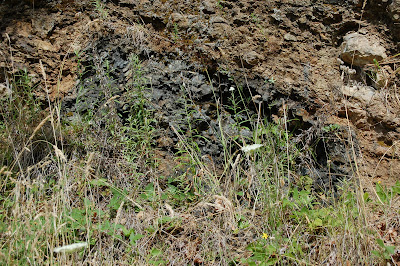While I'm posting this series- more for my convenience than anything else- as discrete segments, I do want to note that I hope readers realize that these different bits were designed to dovetail seamlessly together. Yes, I organized the presentation around a few topics that I wanted to highlight, but it was delivered as one continuous talk, over a period of about an hour and twenty minutes. Moving along from rocks and their human uses to the different kinds of rocks one might find in the Willamette Valley and surrounding areas is a natural transition. I imagine most of the audience didn't even really notice we'd changed topics.
Above is a petrified tree trunk at the community museum in Sweet Home Oregon. The fossilized wood in the Sweet Home- Holley area is spectacularly preserved, with even the finest details observable in thin sections under a microscope. A particular puzzle with respect to this "petrified forest" is its diversity. Over 60 taxa have been ID'd, ranging in environmental affinities from subtropical to boreal. The Cascades were, at the time, low relief, so we can't call on elevation changes as we might today. Ideas include transport from the hinterland, and driftwood coming in from the North. During the time of deposition, Oligocene, the PNW was undergoing a slow climate change from more tropical to more temperate. But the fact is, no one knows for sure. (There's my favorite scientific phrase again!)
Closer to to upper surface of the trunk above, the growth bands are clearly visible.
And if you enlarge this to full size, you can start to make out cellular-level detail.
The dark area in the outcrop above is the "permineralized charcoal" near the upper end of Green Peter Reservoir...
...and above is a photo of a thin section of that material, taken through a microscope. This particular rock type is kind of weird, but it's the best photo I have of local-area petrified wood, and it does a good job of showing the quality of preservation.
Vesicular (gas bubbled) basalt, from near Green Peter Dam. Some of the vesicles are filled in with calcite and zeolites. This would be called amygdaloidal texture, and the infilled holes referred to as amygdules- from the root word meaning "almond," in allusion to the flattened tear-drop shape these holes and infillings often display.
Vein quartz and nice colorful crystals, Quartzville area. Vein quartz like this is quite durable, and frequently shows up in Willamette Valley stream gravel, though crystals of that quality rarely survive transport.
An old gold mine near the historic Quartzville town site. This area is basically a solid mass of cross-cutting quartz veins and quartz breccia.
A volcanic neck (looks like basalt, but I've never actually been up to its base) along Green Peter Reservoir.
Jointed, weathered basalt. I've found over the past few months that many people aren't familiar with the idea of spheroidal weathering. Basically, the rocks start out with an initial set of joints (fractures which have no offset parallel to the fracture surface), which create a batch of angular blocks. Corners are most exposed to weathering, and edges next less. Faces are least exposed to weathering. As most rocks weather chemically, many minerals undergo a transformation into clays, which are less dense, and higher volume. This implies that chemical weathering includes an aspect of expansion. This expansion causes outer layers to pop away from less weathered inner layers. The net result is that over time, initially angular blocks weather to spheroidal blocks, frequently with an "onion skin" appearance. There's a very nice photo of this texture here, (scroll down to "Onion-skin weathering") though the explanation given is no longer accepted as the predominant mechanism by which this texture is created.
Radial jointing. I suspect this was a lava conduit (Cobble Beach, Yaquina Head, near Newport, Oregon)
Columnar joints in Columbia River Basalt, also at Yaquina Head.
Pillow basalts in Siletz River Volcanics, Marys Peak, Oregon.
Basalt dike in Alsea Pass, Siletz River Volcanics, near Marys Peak, Oregon.
A typical exposure of Tyee Formation turbidites, Marys Peak, Oregon, in danger of being completely consumed by green stuff.
A better (and much more unusual) exposure of Tyee Formation turbidites, Marys Peak, Oregon. On the Coast Range side of the valley, this rock unit and similar ones are the most common. However, they do not survive weathering very well, so they don't tend to be seen out on the valley floor.
Is This Your Hat?
11 years ago


























No comments:
Post a Comment